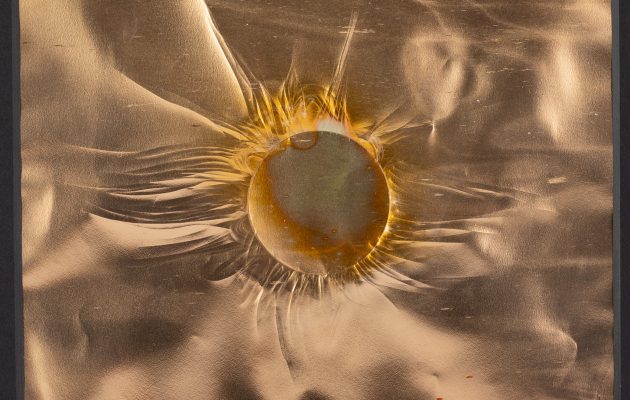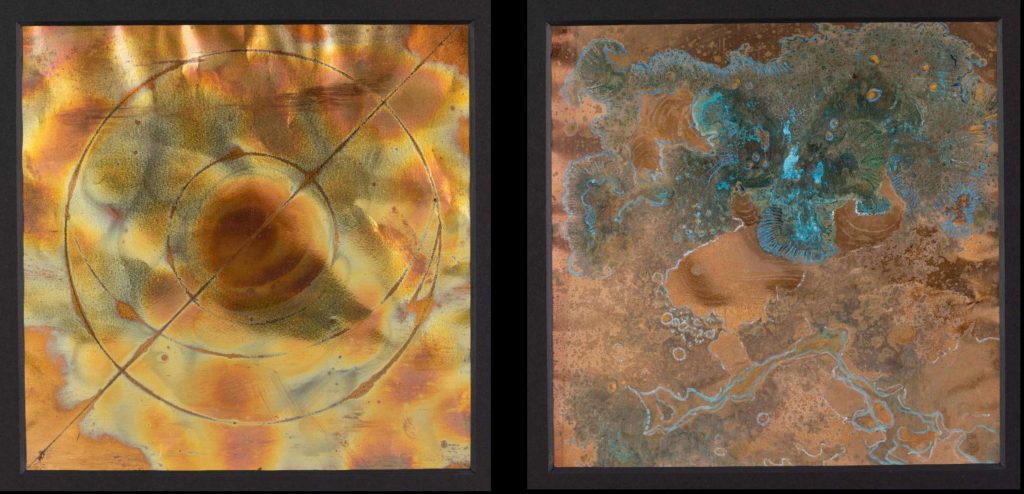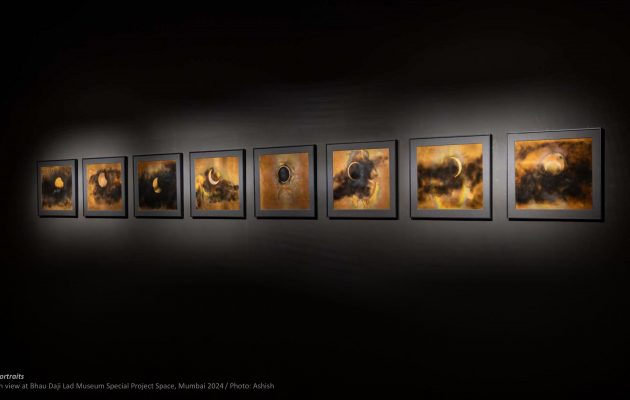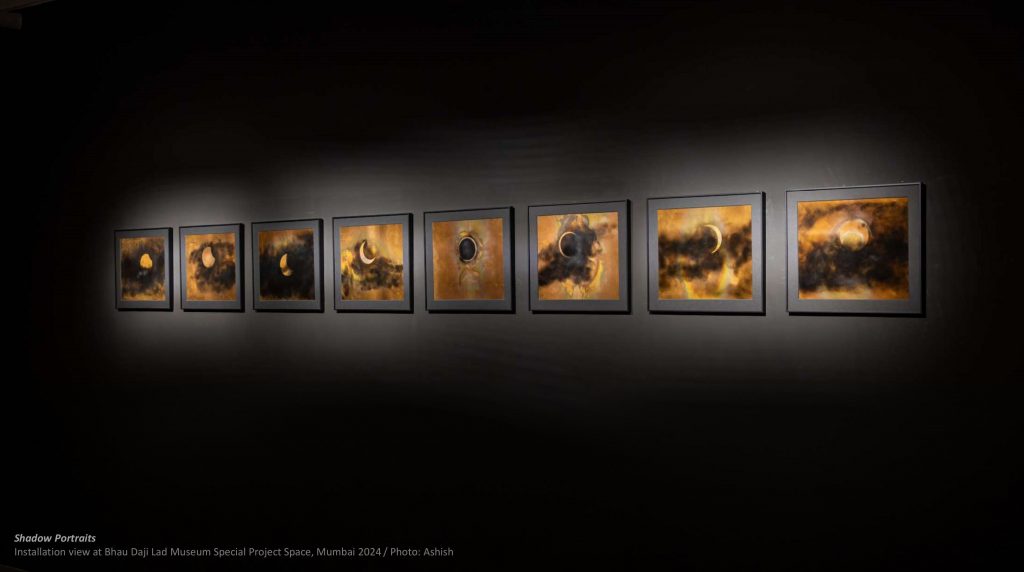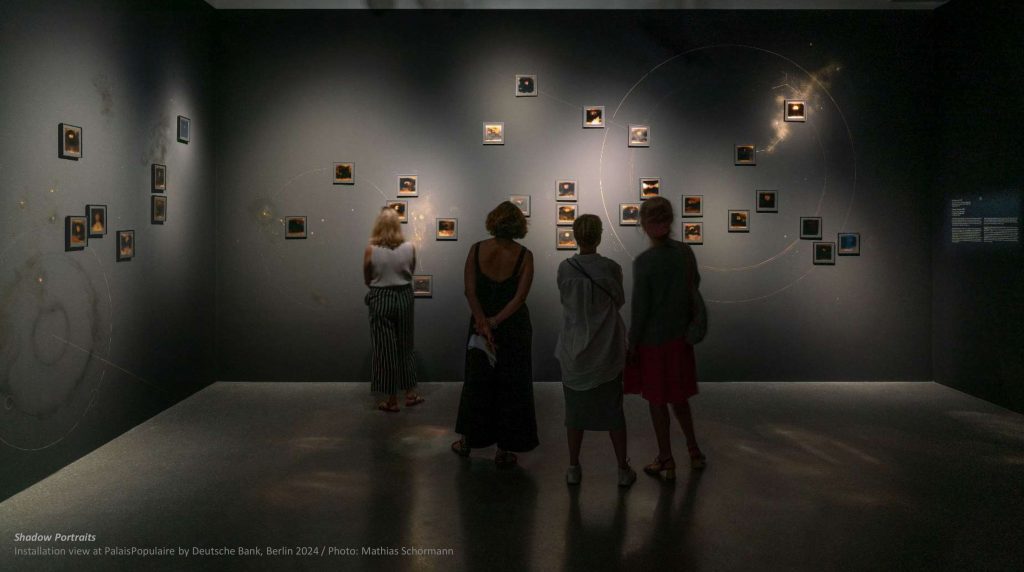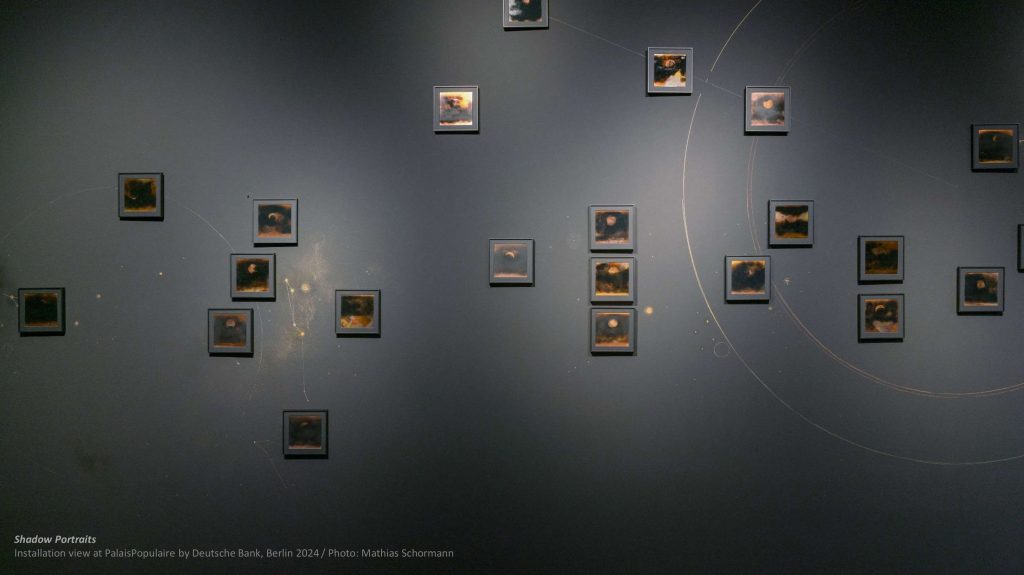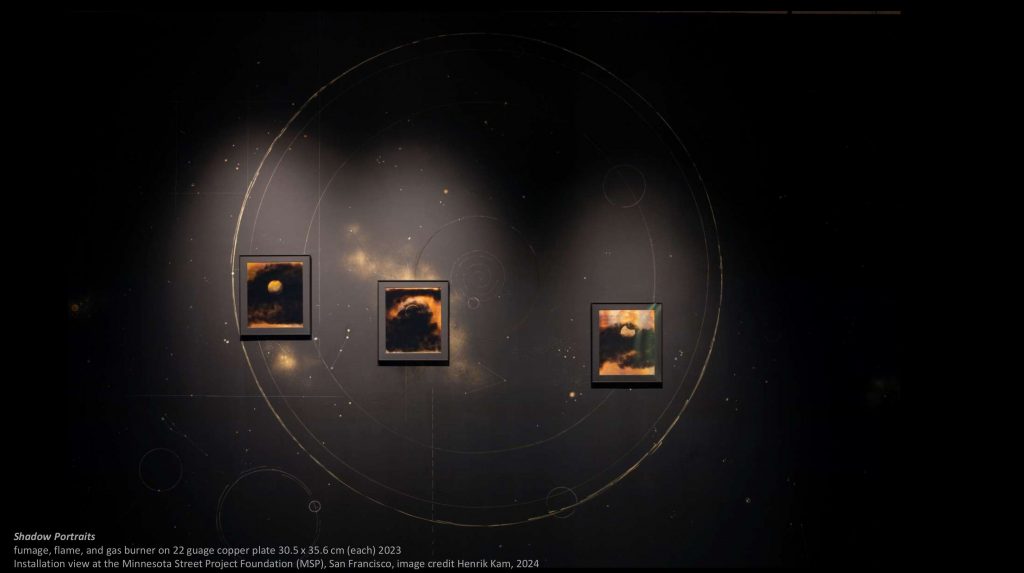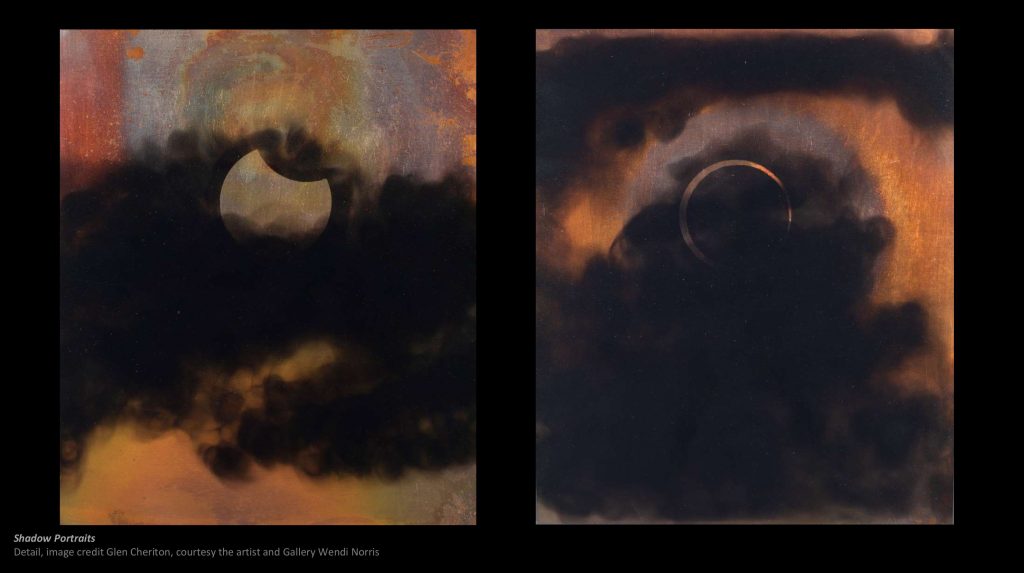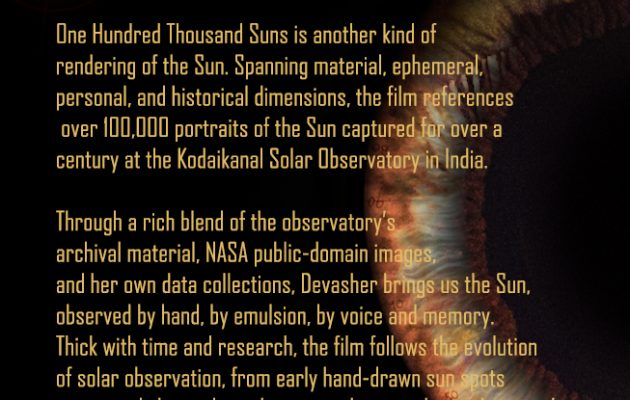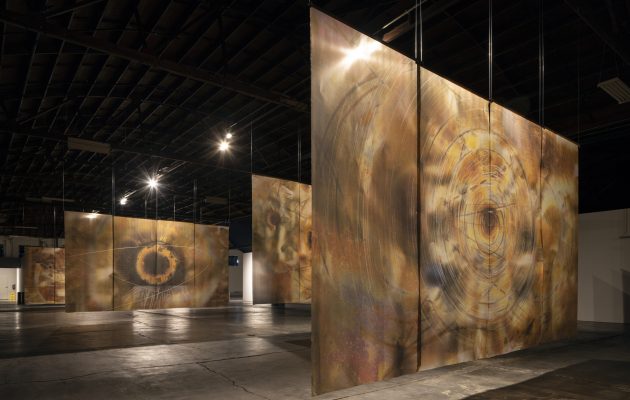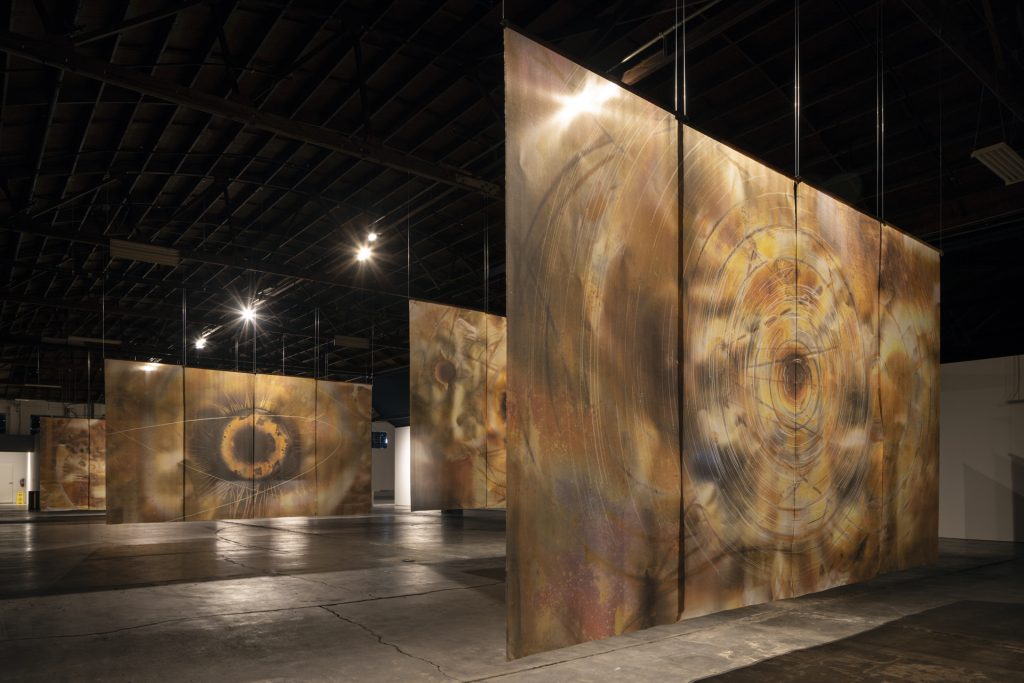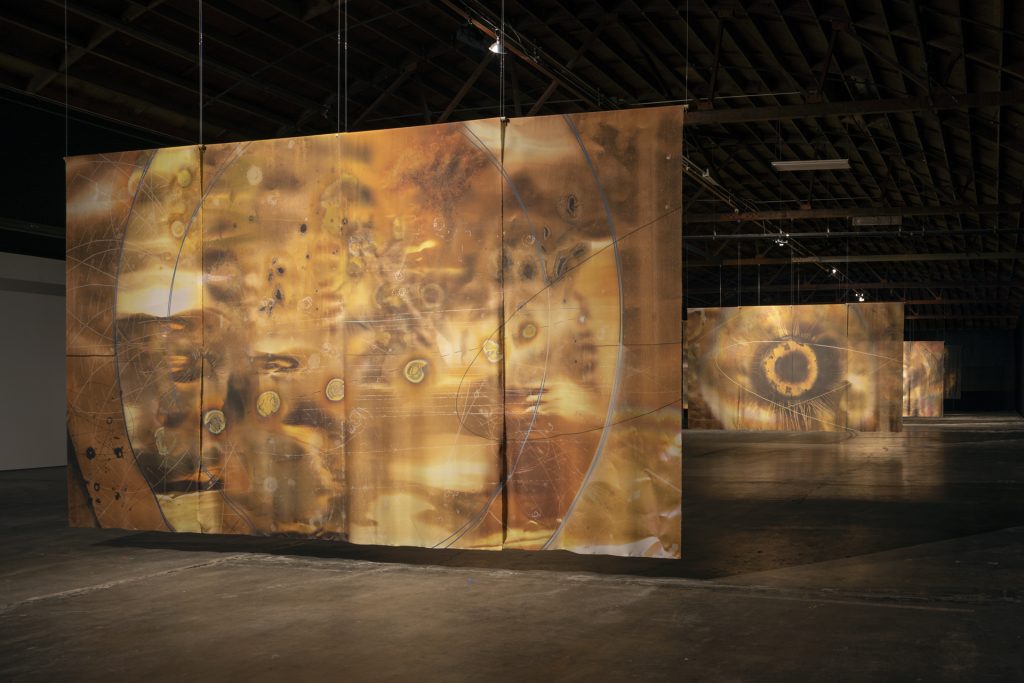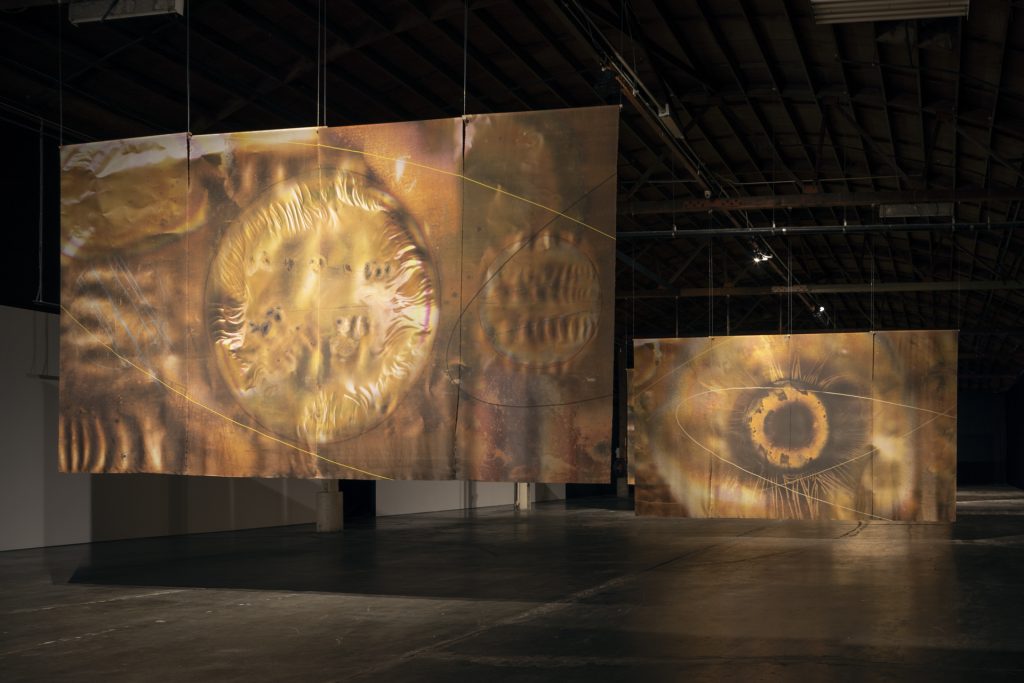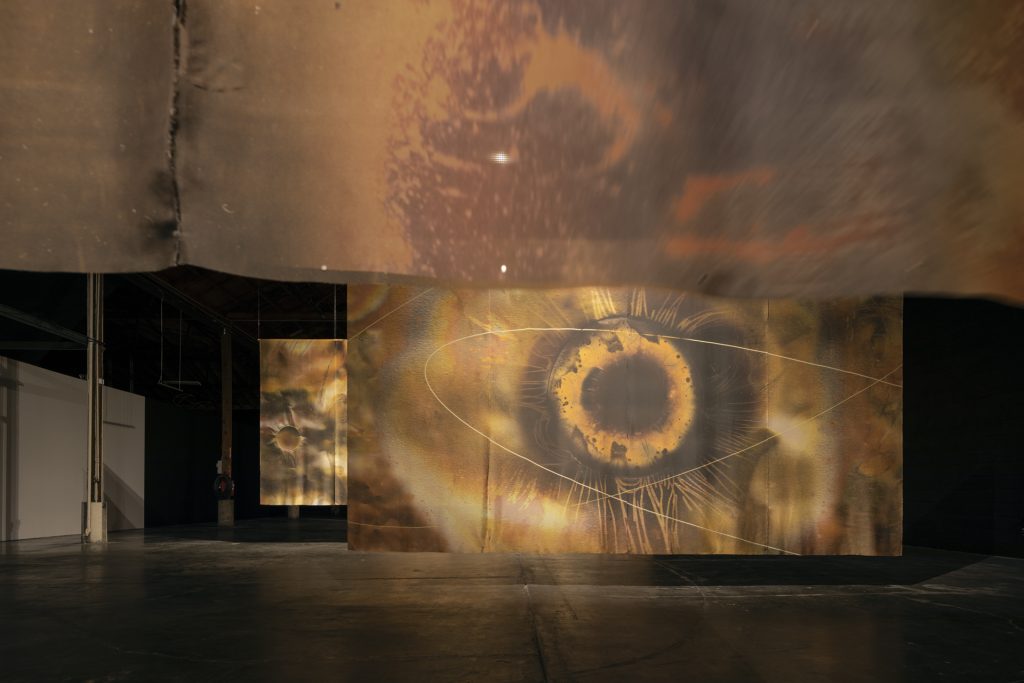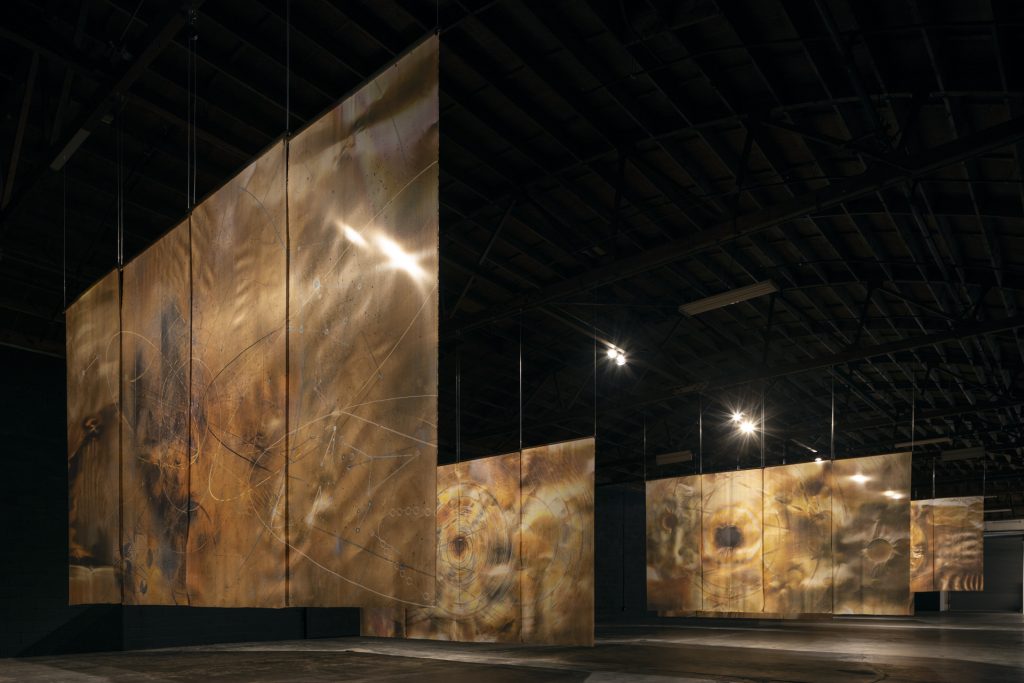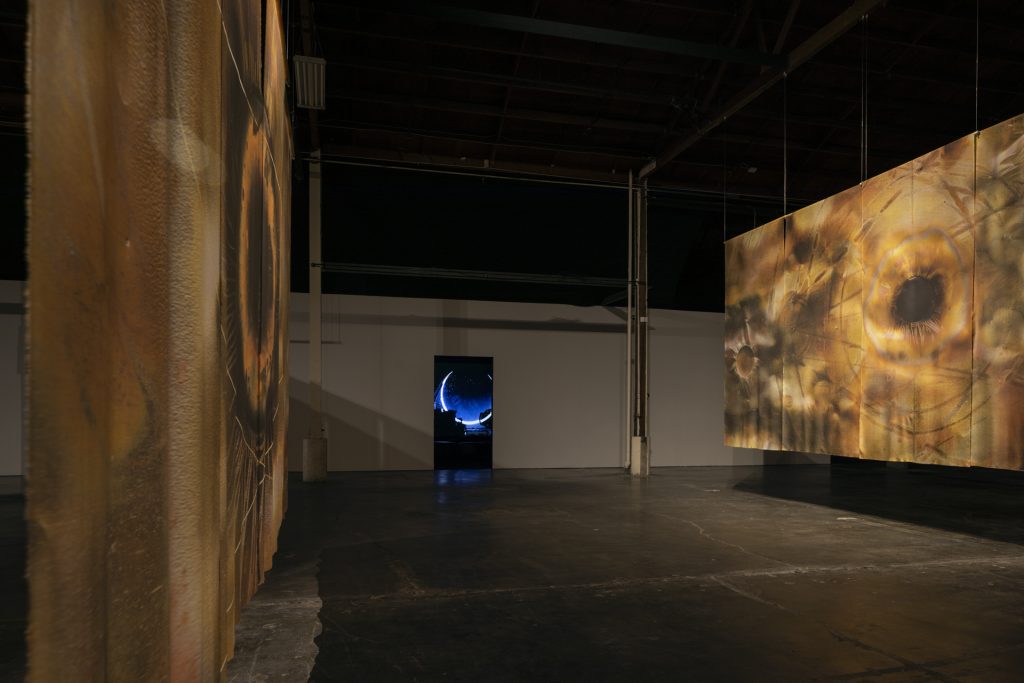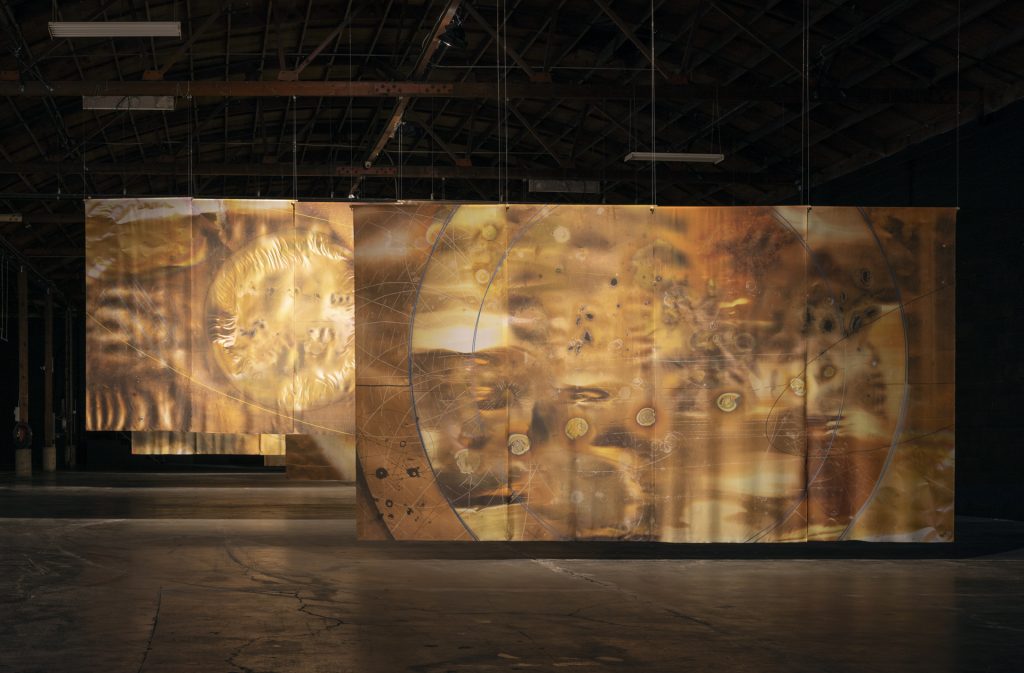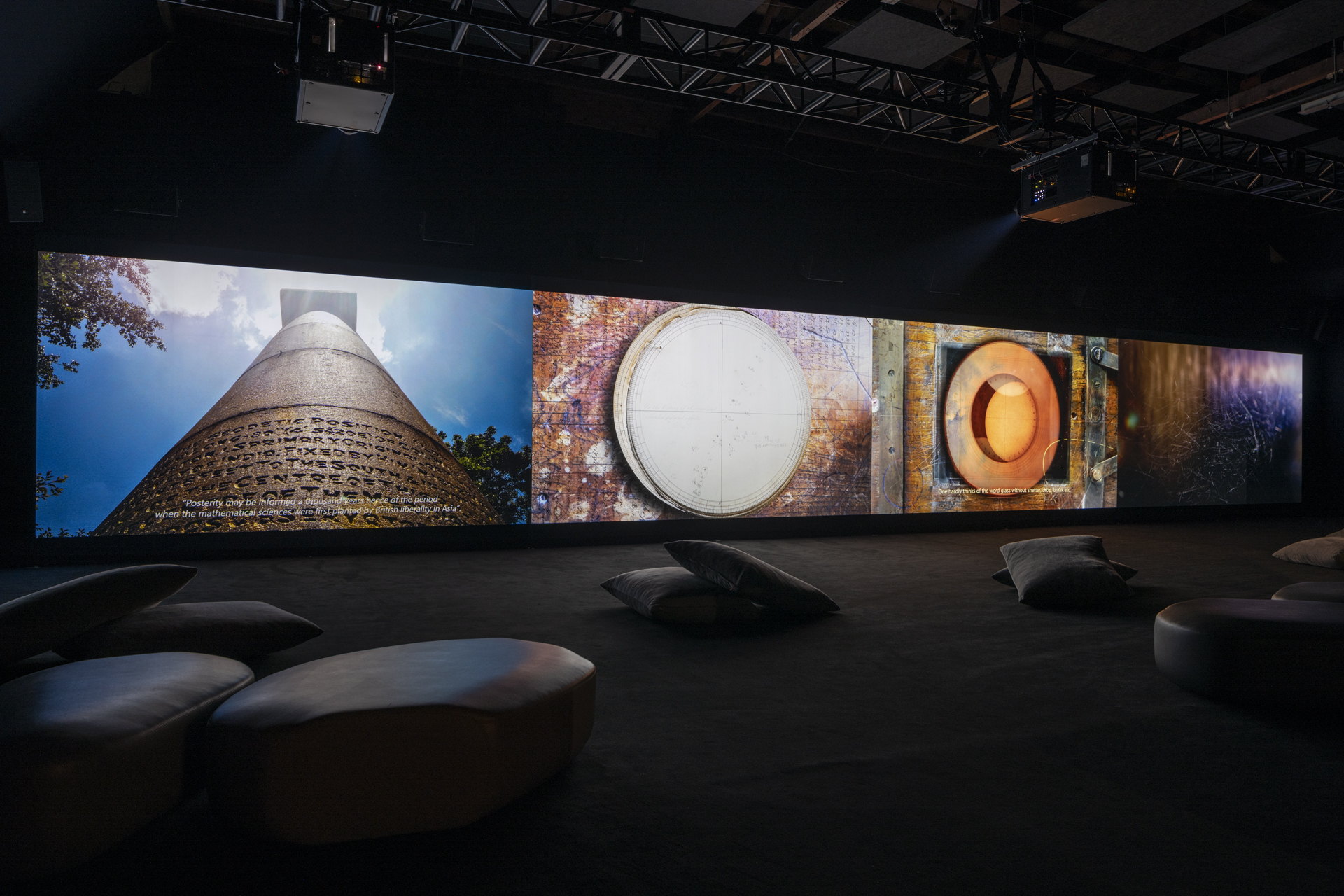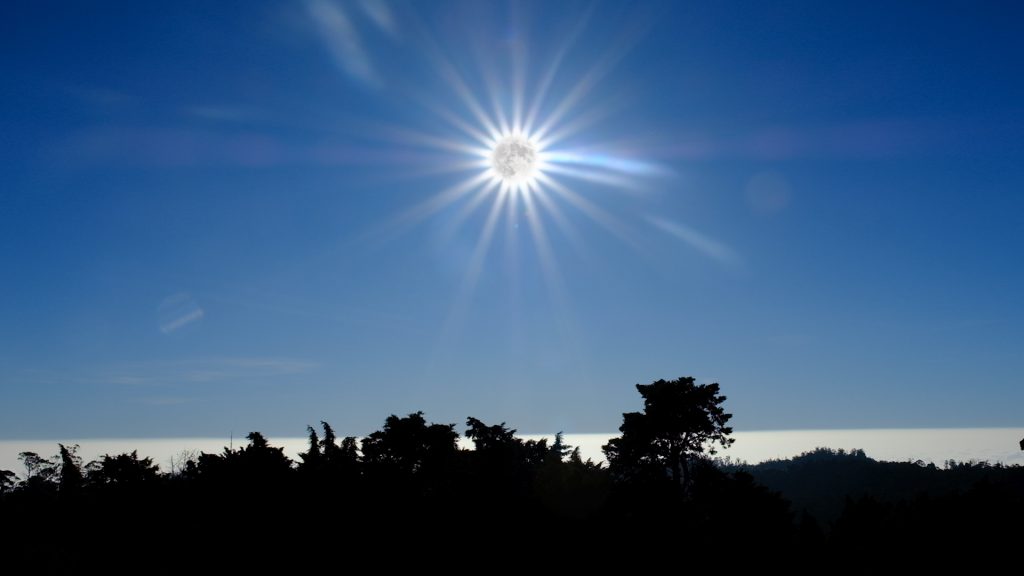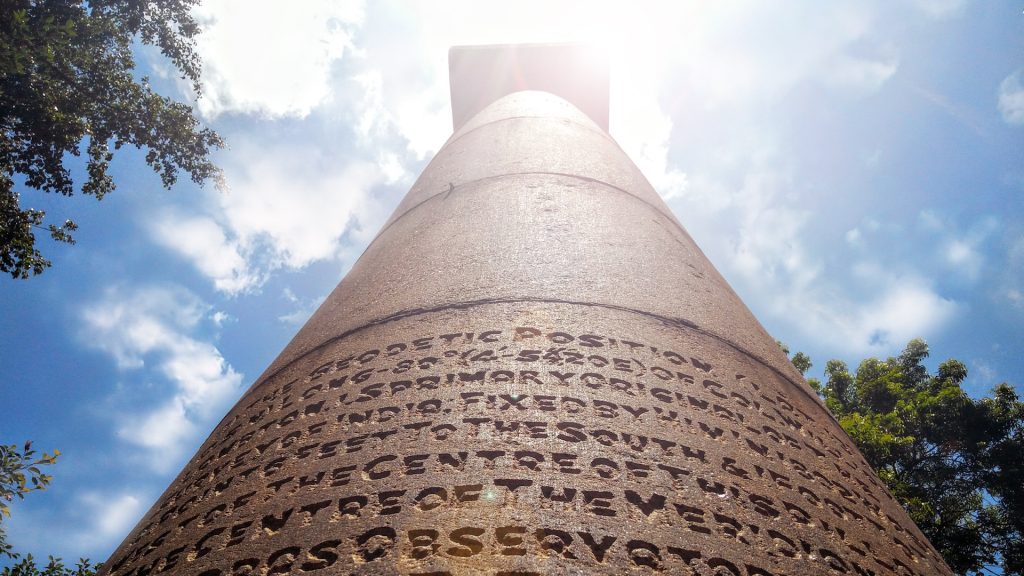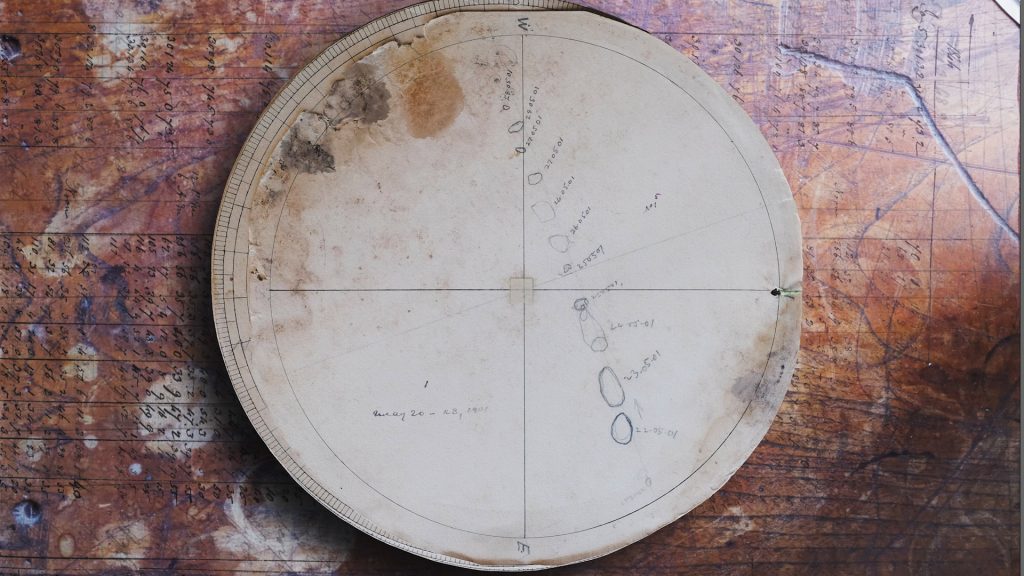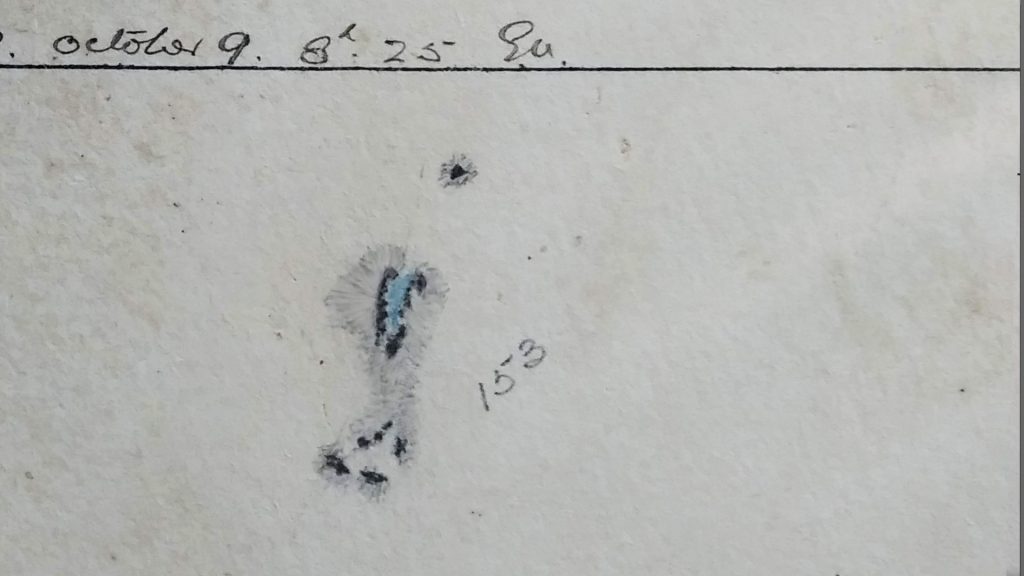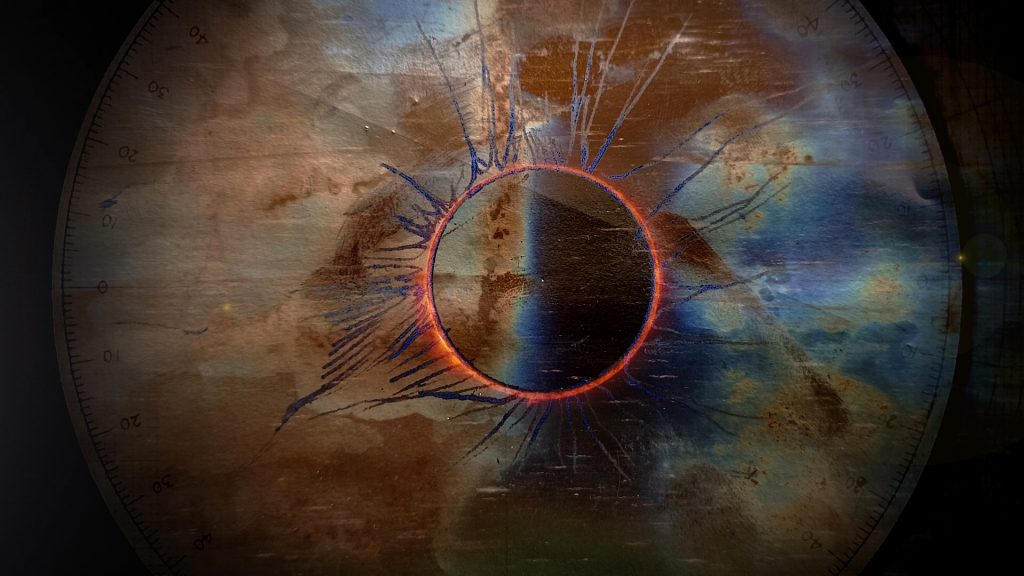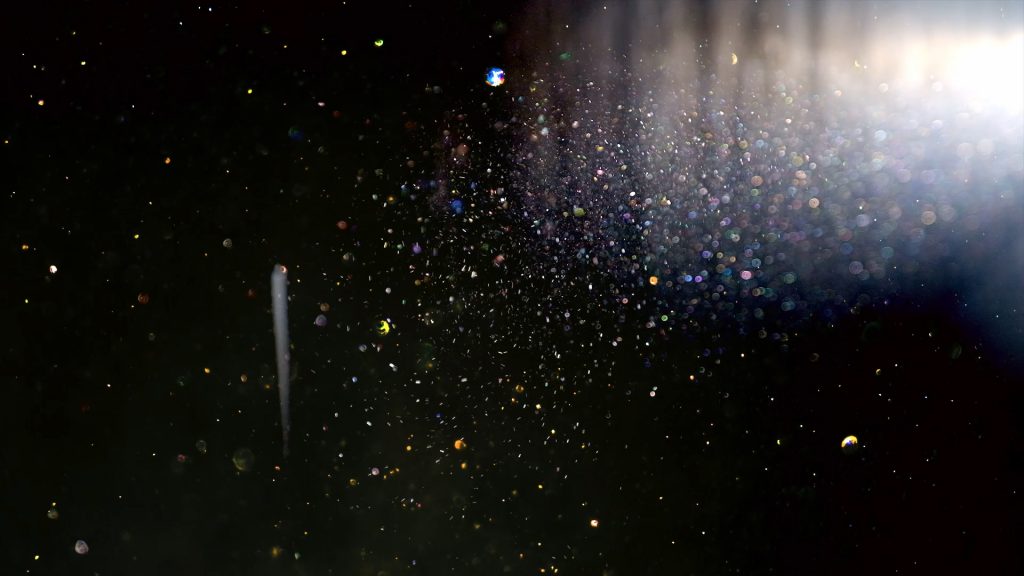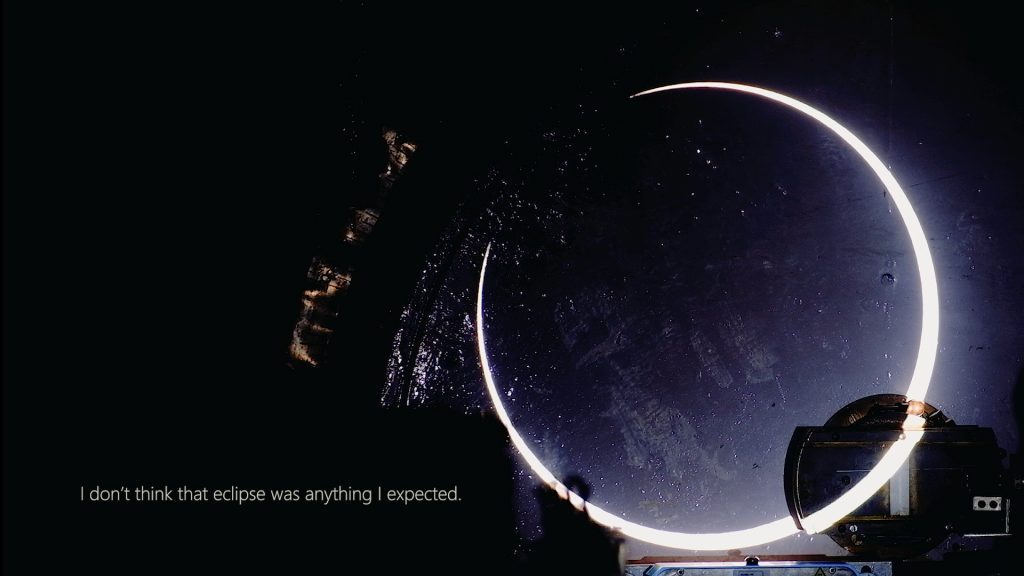
Paradigm 3: Twin Suns (video still)
Every day, weather permitting, since 1904,
the staff at the Kodaikanal Solar Observatory in India, have recorded images of our Sun.
125 years of solar data.
Almost 11 solar cycles.
More than 157,000 distinct portraits of our nearest star.
______________
A close reading of the interplay between site, observer and observation is key in the exploration of the relationships between the human and non-human. These themes are central to my practice which explores the intersections between the humanities and the sciences. One Hundred Thousand Suns, brings together work especially informed by my two-decade engagement with astronomy.
The body of work includes four distinct yet linked bodies of work.
1 One Hundred Thousand Suns, 4 channel synced film installation
2 Latent Fields, inkjet prints on silk
3 Shadow Portraits, fumage on copper plate
4 Sol Drawings, drawing, fumage on copper sheet
The film debuted simultaneously on two continents: at the Museum Catharijneconvent in Utrecht, Netherlands; the Kunsthalle Bern, Switzerland and at MSP Foundation in San Francisco, California, in collaboration with Gallery Wendi Norris. It also previewed in Mumbai at Dr. Bhau Daji Lad Museum, India, in November 2024. As a counterpoint to this cinematic and enveloping presentation, Gallery Wendi Norris concurrently hosted Sol Drawings, an intimate show of two-dimensional works on copper.
______________
One Hundred Thousand Suns and Latent Fields were presented by the Minnesota Street Project Foundation in collaboration with Gallery Wendi Norris.
One Hundred Thousand Suns was presented by the Dr. Bhau Daji Lad Museum in collaboration with Project 88, Mumbai.
One Hundred Thousand Suns was commissioned by Data as Culture at the Open Data Institute (ODI) as part of an Evidence & Foresight online artists’ residency 2021-22.
This work would not have been possible without the generous support of the Indian Institute of Astrophysics, (IIA) Bengaluru and the Kodaikanal Solar Observatory.
Part of the research for this piece was made possible as part of Five Million Incidents, 2019-2020 supported by Goethe Institut / Max Mueller Bhavan, New Delhi, in collaboration with Raqs Media Collective.
About Minnesota Street Project Foundation
Established in 2019, the Minnesota Street Project Foundation’s mission is rooted in our unwavering dedication to the visual arts in every facet. We operate on the belief that the future of philanthropic support for the arts requires an alternative model. By providing space and infrastructure for the creation and exhibition of the contemporary arts we generate sustainable support for the Bay Area arts communities. Our programming enables new arts initiatives, collaborations, public exhibitions, and capacity building grants.
Located in San Francisco’s Dogpatch district, Minnesota Street Project Foundation is part of the contemporary art campus that is home to Minnesota Street Project, a for-profit enterprise that includes over a dozen art galleries, art non-profits, the acclaimed Besharam restaurant, and the affiliated Minnesota Street Project Art Services. 100% of Art Services’ profits are used to support the artists, galleries, and institutions that comprise the Project and the Foundation.
About Gallery Wendi Norris
Gallery Wendi Norris is a leading international art gallery with headquarters in San Francisco, California. The gallery holds decades-long relationships with 20th century luminaries such as Leonora Carrington, Dorothea Tanning, Wolfgang Paalen, Remedios Varo, and Alice Rahon, artists whose nomadic and visionary practices interrogated the aesthetic, scientific, and philosophical movements of their times. The gallery also represents Ambreen Butt, María Magdalena Campos-Pons, Chitra Ganesh, Julio César Morales, Ranu Mukherjee, Eva Schlegel, Peter Young, and other contemporaries, artists whose work similarly flows across disciplines, continents, and generations as they speculate on the present moment.
Opened in 2002, Gallery Wendi Norris remains committed to its founding principles of rigorous programming, development of artists’ legacies, public accessibility, and cultural significance. To those ends, the gallery hosts visiting academics, sponsors artist talks, and publishes highly-researched books with original contributions from international scholars. The gallery actively supports artists in engaging new audiences through influential commercial, biennial, and institutional collaborations. Pioneering an offsite exhibition model in 2017, the gallery produces public-facing artworks and shows wherever they might reach the widest viewership and provide the deepest impact. Working in concert with major museums, private collectors, and innovative curators, Gallery Wendi Norris builds enduring, well-represented collections for its respected array of international clients.
About Dr. Bhau Daji Lad Museum
The Dr. Bhau Daji Lad Museum is Mumbai’s oldest museum, established in 1857 and is the erstwhile Victoria and Albert Museum, Bombay.
The Museum building and collections underwent a comprehensive, UNESCO-Award winning restoration, spearheaded by the Mumbai Chapter of the Indian National Trust for Art and Cultural Heritage (INTACH), and supported by the Municipal Corporation of Greater Mumbai and the Jamnalal Bajaj Foundation. The project involved an institutional overhaul and training an all new staff. Since it opened to the public in 2008, the Museum has pioneered contemporary art which is presented in the extraordinary 19th-century building, one of the finest in India, in an attempt to rethink the cannon and
challenge colonial and Enlightenment precepts.
The Museum was built to showcase the city’s contemporary art and craftsmanship through a rare collection of fine and decorative arts of India. The Museum’s robust exhibition and outreach program invites artists to engage with these collections and archives and interrogate its founding principles.
Over 85 exhibitions have been presented, which include collaborations with both local and international institutions and organizations. Past exhibitions have showcased contemporary creative practices in design, crafts and textiles, architecture, urbanism, and film and video art.
About Project 88
Project 88 inhabits 4000 square feet of what was formerly a century old metal printing press in Colaba, Mumbai, restored and renovated by Rahul Mehrotra. It has a roster of some of the most thoughtful and exciting artists working in the Indian subcontinent today. If you want to know what constitutes the future of contemporary art in South Asia, Project 88 is the place from where you could begin your exploration of tomorrow’s terrain.
From it’s inception in 2006 and under the adventurous directorship of Sree Banerjee Goswami, Project 88 have developed a context for the exhibition of experimental and ambitious work in all media by artists who’s practice have strong conceptual foundations. A second generation gallerist, Sree grew up with art in Kolkata where her mother Supriya Banerjee founded Galerie 88, Kolkata, in 1988, working with illustrious artists such as M.F. Hussain, Ram Kumar, Akbar Padamsee, Meera Mukherjee, Ganesh Pyne, Somnath Hore, K.G. Subramaniam, etc.
Project 88 remains committed to the discovery and nurturing of emerging talent, even as it works with cutting-edge, intelligent, internationally known mid-career artists from South Asia and elsewhere. The gallery regularly participates in various art fairs, including Frieze London and New York, ARCO Madrid, Art Basel Hong Kong, Art Dubai and India Art Fair. Many of it’s artists are in major international collections and are featured regularly in the most prestigious biennales and museum shows. The future of the art landscape is being shaped here.
About Museum Catharijneconvent
The permanent collection of Museum Catharijneconvent comprises unique historical and art-historical exhibits ranging from the early medieval period to the 21st Century. This collection offers an insight into the Christian art and cultural history of the Netherlands and its influence on Dutch society.
It includes richly illuminated manuscripts, jeweled book bindings, richly decorated images, unique paintings, altar pieces, ecclesiastical vestments and artifacts of gold and silver. Dutch art from the Golden Age of the 16th and 17th centuries is represented by Jan van Scorel, Rembrandt, Frans Hals and Pieter Saenredam. Of more recent vintage are works by Jan Toorop, Shinkichi Tajiri and Marc Mulders. The Museum Catharijneconvent collection contains both Protestant and Catholic artifacts, making it unique in the world.
Museum Catharijneconvent exhibits the past and present of Christian heritage in the Netherlands, with centuries-old and contemporary art and artifacts. The more than 65,000 items in Museum Catharijneconvent’s collection are all included in the database, now accessible on the internet. The museum library, with more than 40,000 books, articles, and periodicals on Christianity in the Netherlands, is also available online.
Museum Catharijneconvent has a long and colorful history. Originally built in the 16th century as a monastery for members of the Order of the Knights of St. John, it was named after Saint Catherine of Alexandria. The monastery’s infirmary eventually became Utrecht’s first teaching hospital while the Catharijneconvent was subsequently used for a wide variety of purposes. Having provided accommodation for the military, and for student fencing and acrobatics clubs, it was used for many years as a school gymnasium and has housed a number of museums. After a complete refurbishment, the current Museum Catharijneconvent was officially opened by the then Queen Juliana on June 9, 1979.


